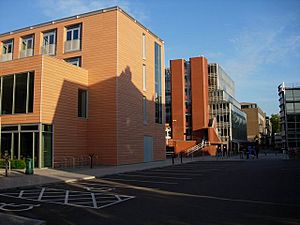Department of Anglo-Saxon, Norse and Celtic, University of Cambridge facts for kids
The Department of Anglo-Saxon, Norse and Celtic (often called ASNC or ASNaC) is a special part of the University of Cambridge. It focuses on the history, culture, languages, and stories of people who lived in Britain, Ireland, and the Scandinavian world long ago. This covers the early Middle Ages, from the 5th to the 12th century.
The department is located on the second floor of the Faculty of English building at 9 West Road. Students who study here are often called ASNaCs. This department is unique because it's the only one in the world that focuses entirely on this early medieval period.
Contents
What's in a Name?
The name Anglo-Saxon, Norse and Celtic was chosen in 1971. Before that, it was called the Department of Anglo-Saxon and Kindred Studies.
The short name ASNC or ASNaC is said like "az-nak". It started as a funny nickname for members of the ASNC Society. The name came from a poster that said: 'A Snack for ASNACs'. Over time, students in the department simply became known as 'Asnacs'.
A Look at ASNaC's History
Studying early England and its neighbors has a long history at Cambridge. It began way back in the 1500s with Archbishop Matthew Parker. Later, in the 1600s, John Spelman helped fund William Somner to create the very first dictionary for Old English.
In the 1800s, people like John Mitchell Kemble and Joseph Bosworth helped bring back the study of Old English. Bosworth even set up a special teaching position, the Elrington and Bosworth Chair, in 1878.
Important scholars like Eiríkur Magnússon helped build up the study of Old Norse. Edmund Crosby Quiggin did the same for Celtic studies.
The ASNaC Department we know today really started with Hector Munro Chadwick in 1928. He wanted to combine the study of Old English with archaeology and history. He moved these studies from the English Faculty to Archaeology and Anthropology.
Later, in 1967, Professor Dorothy Whitelock moved the Anglo-Saxon studies back to the English Faculty. In 1971, the degree program was officially renamed 'Anglo-Saxon, Norse and Celtic'. In 1992, under Michael Lapidge, the ASNC degree became a three-year course.
The department also holds three public lectures each year: The H.M. Chadwick Lecture, The Kathleen Hughes Memorial Lecture, and The E.C. Quiggan Memorial Lectures.
What ASNaC Researches
The ASNaC department is known for its excellent research. In 2008, it was ranked as the top department for Celtic Studies in the UK. Much of its research was considered "internationally excellent" or "world-leading."
The department also works with King's College London on a big project called the Prosopography of Anglo-Saxon England. This is a free online database of people from Anglo-Saxon England.
Languages You Can Learn
Learning languages is a big part of studying at ASNaC. The department teaches students from the very beginning (ab initio) how to speak and understand:
- Old English
- Old Norse
- Old Irish
- Middle Welsh
- Latin
Because ASNaC is so good at teaching Scandinavian and Celtic studies, the governments of Ireland and Iceland even provide money to help teach Modern Irish and Icelandic to students at Cambridge University.
Student Life
Joining ASNaC
Between 1900 and 1999, about 860 students studied in the department. In the early years, more women studied here. Later, it was a mix of men and women.
More recently, from 2009 to 2012, about 50 to 60 students applied for the ASNC degree each year. About half of them were offered a place, and around 20-25 students accepted. Most of the undergraduate students are female, and many come from state schools.
The ASNaC Society
The department has its own student group called the ASNaC Society. This society has been around since at least 1971. It helps students feel like they belong to a special group.
The ASNaC Society organizes fun activities like:
- A weekly 'ASNaC Lunch'
- Field trips
- Punting (boating) trips
- Dinners
- They even have ASNaC mugs and sweatshirts!
The society also creates a funny student magazine called Gesta Asnacorum. It makes jokes about department life and the old texts they study. Many students who went on to become famous historians wrote for this magazine when they were younger.
In 2022, the ASNC society launched a new website.
Famous ASNaC Alumni
Many students who studied at ASNaC have gone on to do amazing things in different jobs. A lot of them became important academics who study early medieval European history and literature, especially Celtic studies. This shows how important the department has been in its field.
Some notable people who studied at ASNaC include:
- Florence Harmer (finished degree in 1912)
- Audrey Meaney (graduated 1959)
- David Denison (graduated 1973)
- Philip Jenkins (graduated 1974)
- Andrew Breeze (graduated 1976)
- Sarah Foot (started in 1979)
- Julia Crick (started in 1982)
- Richard Sharpe (graduated 1977)
- Alaric Hall (graduated 2000)
- Jane Stevenson, a historian and novelist
- Tom Shakespeare, an academic and disability campaigner
- Stephan Grundy, a novelist
- Elin Manahan Thomas, an opera singer
- Dan Starkey, an actor
- Rebecca Dowbiggin, a rower
- Paul Best, a cricketer



